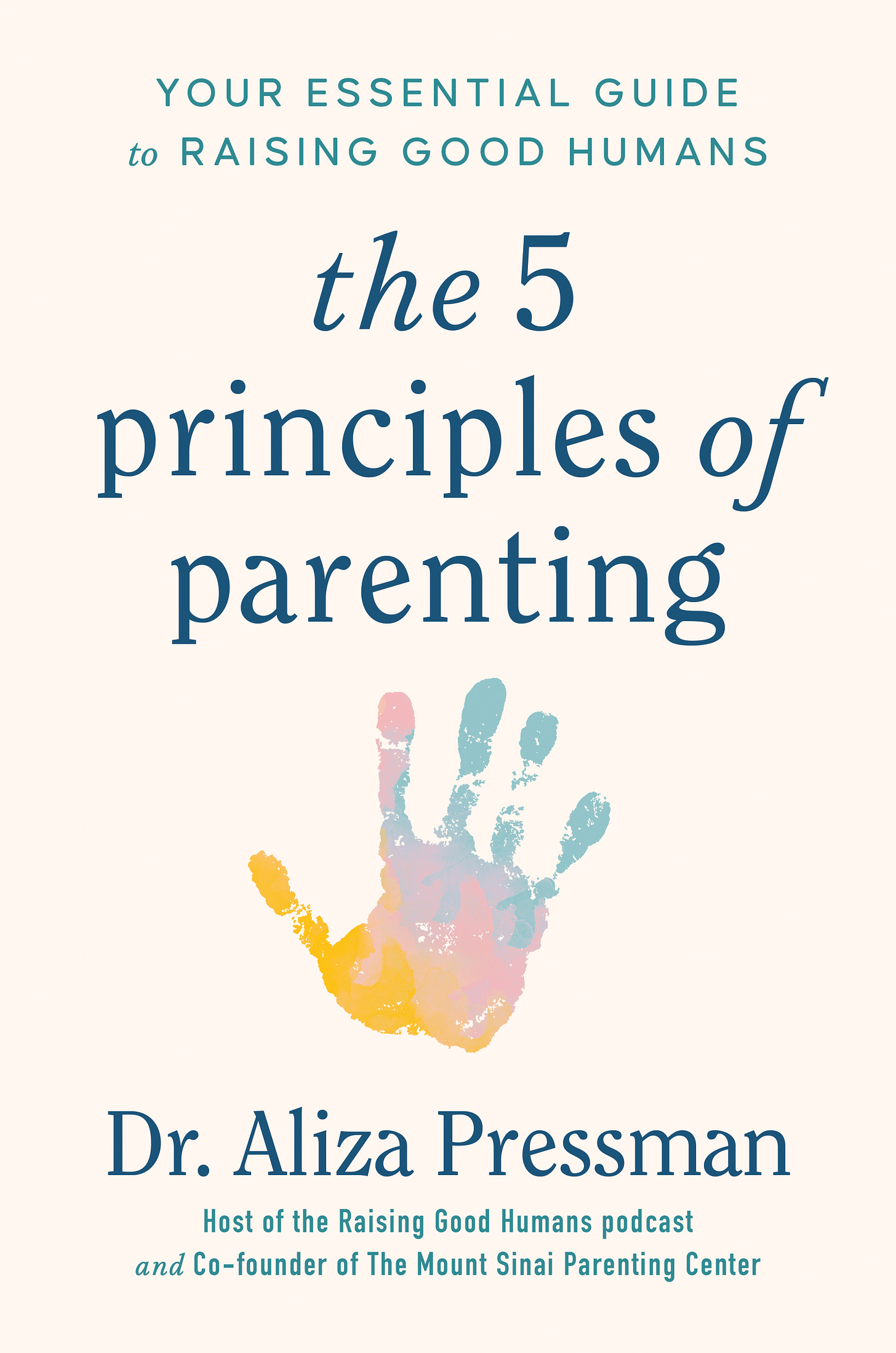Thanks for reading Raising Good Humans on Substack! My first book, The Five Principles of Parenting: Your Essential Guide to Raising Good Humans is now available for purchase here.

In this week’s episode of Raising Good Humans Podcast, I wanted to bring you really practical examples of parenting more highly reactive kids. Parenting a "big reactor" can be an emotional rollercoaster, often leaving you questioning your every move. You love your child deeply and want to honor their sensitivity with your supportive caregiving, yet you're also aware of the importance of setting firm limits. This creates a confusing internal battle: "Am I being too lenient?" or "Am I hurting their spirit by being too strict?" You may feel like you're walking a tightrope, trying to balance compassion with discipline, and constantly worrying if you're getting it right. It's exhausting and often isolating.
Below are some of the practical challenges Claire Lerner, LCSW, and the author of the upcoming book, Big Reactors: Practical Strategies for Parenting Highly Sensitive Children, discusses in the episode.
The Scenarios
Scenario 1: Setting bedtime limits
The challenge: You need personal time to recharge, but a big reactor child may express a strong desire for more time together at bedtime. You may end up feeling guilty or like you are rejecting your child if you try to set a limit, so you end up staying longer than intended, feeling frustrated, and eventually having a bigger reaction yourself.
Responding differently: Instead of giving in or staying longer out of guilt, the focus should be on providing a clear and loving boundary.
Strategy: Communicate the limit with empathy but firmness. Acknowledge the child's feelings ("I know, sweetie, it never is going to feel like enough time..."), but state the boundary clearly ("...but it's a mommy decision that it's time for lights out."). Reassure your child of your love and the continuity of your relationship ("I love you. I can't wait to see you in the morning.").
Why it works: This approach provides security for the child and helps them learn to accept limits. And, it prevents you from becoming overly frustrated, and models healthy boundary setting.
Scenario 2: Avoiding new experiences
The challenge: Big reactors often prefer their comfort zone and avoid new experiences or activities that feel overwhelming. This can manifest in refusing social events or resisting participation in group activities. You may feel hesitant to push your child, fearing it might be "mean" and trying to avoid a tantrum with the path of least resistance.
Responding differently: The loving thing to do is to gently encourage exposure to new experiences as a critical part of your child's growth.
Strategy: Validate your child's fears ("I know this feels scary") and then engage in reality testing to address their specific anxieties ("Let's talk about all the things you're afraid of"). Gently guide your child into the activity, offering them the choice to participate or simply observe.
Why it works: This approach helps the child confront their fears in a supportive environment. Over time, many children will choose to participate, building confidence and a sense of accomplishment.
Scenario 3: Distinguishing wants vs. needs
The challenge: Big reactor children may express strong "wants" that are not necessarily aligned with their developmental "needs." For example, a child might want to stay home and watch TV, but they need opportunities for social interaction or physical activity. You are there to see the birdseye view, but it is confused by the intensity of your child’s reaction.
Responding differently: Honoring your child's temperament involves balancing downtime and solo play with gentle encouragement to step outside their comfort zone to meet their needs.
Strategy: Provide space for rest and individual activities but also create scaffolded opportunities for meeting needs that might feel overwhelming in larger doses. For social needs, this might involve arranging small playdates with a compatible child rather than large group settings. Try getting used to the positive discomfort (for you and them), and talk about past accomplishments that came out of hard work.
Why it works: This helps your child learn that they are capable of overcoming challenges, and gives them tools they can use for the many situations in the future where they will need to push themselves.
Scenario 4: Trying to "sell" a limit
The challenge: You are in a losing battle trying to convince or "sell" a limit to your big reactor child - which often leads to negotiations, power struggles, and even more resistance. It feels like a never ending tank where enough is never enough.
Responding differently: Set clear limits without feeling the need to justify or convince your child to agree. It’s not up to them (nor do they have very good decision making skills). They are allowed to have any reaction they want, your job is to make the decision.
Strategy: State the limit clearly and concisely without extensive explanations. For example, regarding bedtime, simply reiterate the boundary and express love, as in Scenario 1.
Why it works: By having consistent limits, your child learns how to regulate. When they are constantly in charge, learning to adapt and adjust to others (like we do at school, work, and in the real world) isn’t possible.
Scenario 5: You’re own triggers
The challenge: Parenting your big reactor can be emotionally draining. Because you are human, you’re easily triggered by your child's intense reactions, leading you to emotional outbursts and escalating conflict.
Responding differently: Prioritize your own self-regulation and take steps to manage your own emotional state before responding.
Strategy: When feeling triggered, take a break to calm down instead of digging into a power struggle or allowing yourself to be hit. Breaks are loving. Another tool is the "mommy/daddy moment," where you can briefly pause (together or alone) to discuss and agree on a response.
Why it works: This prevents our reactive parenting, helps us to ensure consistency in our responses (what did I say last time and why), and models healthy coping mechanisms (getting into our thinking brain).
A quick reminder to buy my first book, The Five Principles of Parenting, and write a review from wherever you order. Reviews really help to get the book noticed, and to spread the word. Please especially rate and review any books purchased on Amazon (it shockingly really, really matters!). Also, when you receive the book, snap a quick pic with it and post on social media. Share one thing you love about it and help me to get more copies into the hands of parents in your community. Tell a friend about the book, or about something you found helpful in the book. Parents look to each other for advice, and I’d love to be a part of the support you pass on to your loved ones.






I love that these strategies are part of the bigger conversation about effective parenting right now; thanks for sharing the specific scripts. My struggle is, what do you do next if you tell your kiddo, "lights out, I love you" and they follow you screaming into the hallway...?? 🥲
I like this framing of "big reactor."